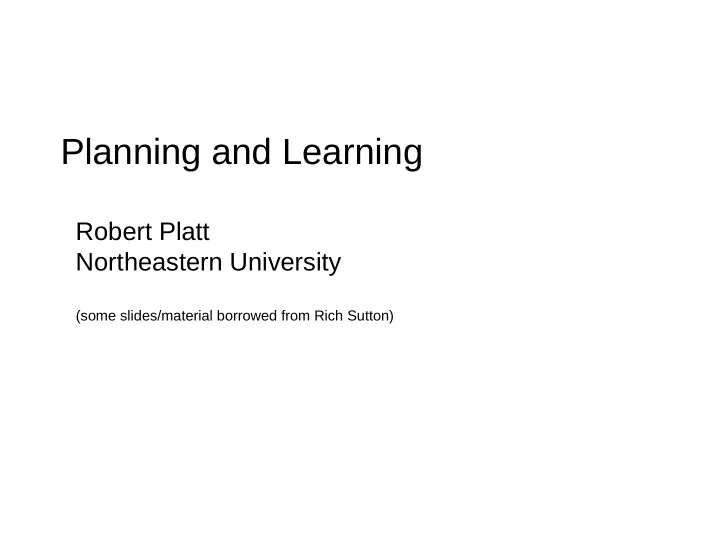

Planning and Learning Robert Platt Northeastern University (some slides/material borrowed from Rich Sutton)
Planning What do you think of when you think about “planning”? – often, the word “planning” often means a specific class of algorithm – here, we use “planning” to mean any computational process that uses a model to create or improve a policy
For example: an unusual way to do planning – why does this satisfy our expanded definition?
Planning v Learning
Planning v Learning Often called “model-based RL”
Models in RL Model: anything the agent can use to predict how the environment will respond to its actions Two types of models: 1. Distribution model: description of all possibilities and their probabilities 2. Sample model: a.k.a. a simulation model – given a s,a pair, the sample model returns next state & reward – a sample model is often much easier to get than the distribution model
Models in RL This is how we defined “model” Model: anything the agent can use to predict how the environment will at the beginning of this course respond to its actions Two types of models: 1. Distribution model: description of all possibilities and their probabilities 2. Sample model: a.k.a. a simulation model – given a s,a pair, the sample model returns next state & reward – a sample model is often much easier to get than the distribution model In this section, we’re going to use this type of model a lot
Planning An unusual way to do planning:
Planning An unusual way to do planning: Here, we’re using a sample model, but we don’t learn the model
Dyna-Q Essentially, perform these two steps continuously: 1. learn model 2. plan using current model estimate
Dyna-Q This “model” could be very simple – it could just be a memory of Essentially, perform these two steps continuously: previously experienced transitions 1. learn model – make predictions based on memory 2. plan using current model estimate of most recent previous outcomes in this state/action.
Dyna-Q on a Simple Maze
Why does Dyna-Q do so well? Policies found using q-learning vs dyna-q halway through second episode – dyna-q w/ n=50 – optimal policy after three episodes!
Think-pair-share
What happens if model changes or is mis-estimated? (SB, Example 8.2) Environment changes here
Think-pair-share (SB, Example 8.2) Questions: – why does dyna-q stop getting reward? – why does it start again?
What is dyna-Q+?
Think-pair-share
Dyna-Q
Prioritized Sweeping Unfocused replay from model
Prioritized Sweeping Unfocused replay from model – can we do better?
Prioritized Sweeping Instead of replaying all of these transitions on each iteration, just replay the important ones… – Which states or state-action pairs should be generated during planning? – Work backward from states who’s value has just changed – Maintain a priority queue of state-action pairs whose values would change a lot if backed up, prioritized by the size of the change – When a new backup occurs, insert predecessors according to their priorities
Prioritized Sweeping TD error what’s this part doing?
Prioritized Sweeping: Performance Both use n=5 backups per environmental interaction
Trajectory sampling Idea: dyna-Q while sampling experiences from a trajectory rather than uniformly, i.e. from the on-policy distribution – is it better to sample uniformly or from the on-policy distribution?
Recommend
More recommend